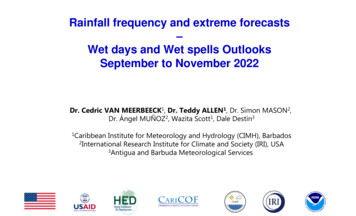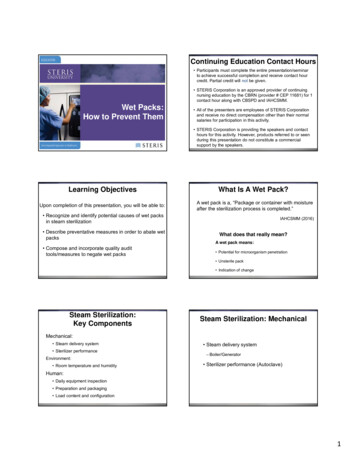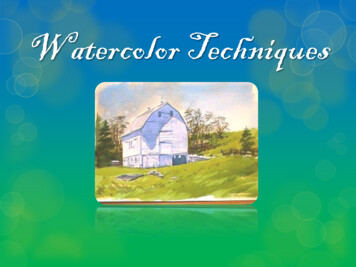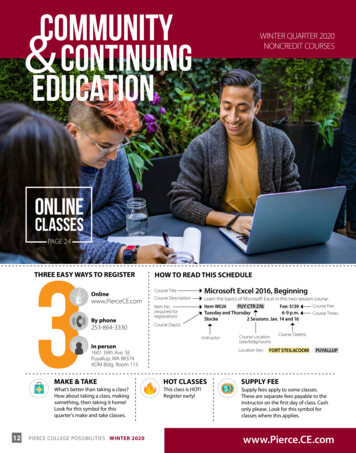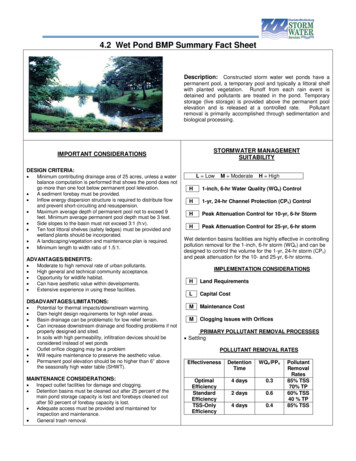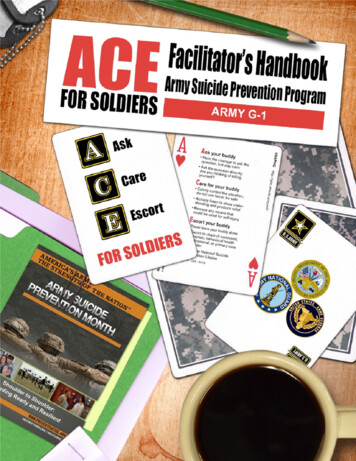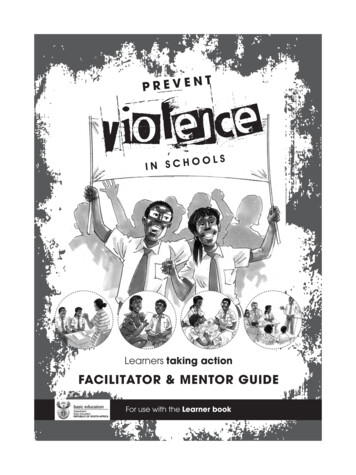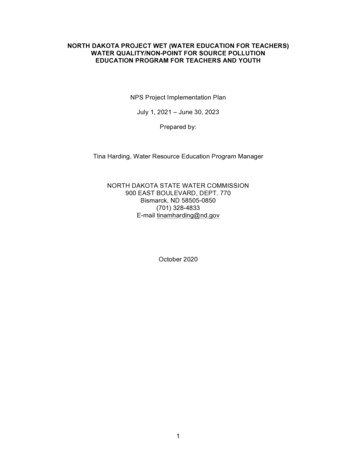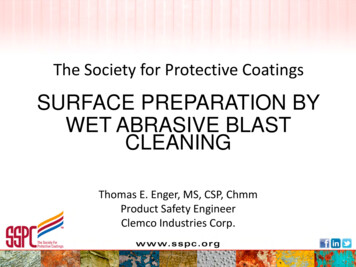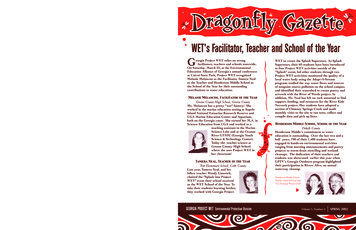
Transcription
by Diane Davies, State 4-H Specialist, Environmental EducationFor more than 20 years, I have watchedthe ebb and flow of decision making inschools concerning field trips. I have cometo realize that this dance of back and forthcan have enormous consequences onchildren's lives.school to our Environmental Education program on Jekyll Island. The teacher hadspoken to our coordinator about her reluctance to bring these two students on the trip.They were disruptive, had poor grades and were generally out of control. They werewell on their way to becoming juvenile delinquents.Encouraged by our staff to bring them on the trip, the teacher reluctantly agreed todo so. These children had never traveled out of their county, let alone to the coast.But when these two boys were given the chance to come, experience and learn,Our program, the Georgia 4-H Environmentaltheir lives were transformed. For the first time, they realized that there was aEducation Program offered at Rock Eagle, Jekyll,whole new world out there that was interesting and intriguing and that capturedTybee and Wahsega 4-H Centers, exists in large parttheir imagination. They chased fiddler crabs across the marsh, they walked onbecause there have always been teachers andthe beach and identified creatures that had washed up. They had fun learningprincipals out there who understand that educationnew things and seeing a different world than the one they had known in thejust doesn't happen within the four walls of thecity. This experience opened their eyes and made them realize that they mighttraditional classroom. They understand the importancelike to pursue a career in this area. On the bus trip back to Atlanta, theyand absolute necessity of providing learningboth told their teacher that they wanted to become marine biologists. Theyopportunities to their students in the one outside theirsubsequently raised their grades and became A and B students and bothdoors, the real world. When a field trip is denied,went on to college to pursue degrees in marine biology.whether that trip is to one of our centers, a zoo, museum,aquarium, farm or nature center, the losses, although notGeorgia, just like all of the other states in America, has suchyet tangible or observable, will play out over time. But themagnificent treasures in the beauty and grandeur and intrigue of thehard reality of these decisions, make no mistake, will fall mostland. It is a natural teacher, the best teacher. In our collectiveheavily on the students who have been denied thesedecisions to try to make education more effective or raise studentlearning opportunities.test scores even higher, we must be open to use the obvious. Thenatural environment of the land holds so much mystery andI have heard so many stories from teachers over my career ofwonder for children and the child that still lives in us.what a trip to our centers meant to their students and how itchanged their lives. But the one that has stayed with me the longestis the one about two students that came with their metro Atlanta areaDiane Davies, State 4-H Specialist, Environmental Education 350 Rock Eagle Rd Eatonton GA 31024Phone# 706-484-2872 Fax: 706-484-2888 e-mail: ddavies@uga.edu, web address: georgia4h.orgU.S.POSTAGE4220 International Parkway, Suite 101, Atlanta, Georgia 30354What’s Inside this Issue?Award-Winning Teachers New Partnership Free Stuff Diving into Ponds WET's Facilitator, Teacher and School of the YearGeorgia Project WET relies on strongfacilitators, teachers and schools statewide.On Saturday, March 23, at the EnvironmentalEducation Alliance of Georgia’s annual conferenceat Unicoi State Park, Project WET recognizedMelanie Melancon as the Facilitator, Tamera Nealas the Teacher and Henderson Middle School asthe School of the Year for their outstandingcontributions to water education.Melanie Melancon, Facilitator of the YearGreene County High School, Greene CountyMs. Melancon has a pretty "wet" history! Sheworked in the marine education setting at SapeloIsland National Estuarine Research Reserve andUGA Marine Education Center and Aquarium,both on the Georgia coast. She earned her M.A. inScience Education from UGA and worked as ateaching assistant in the MarineScience Labs and at the OconeeRiver GYSTC (Georgia YouthScience & Technology Center).Today she teaches science atGreene County High Schoolwhere she uses Project WET inher classroom!Tamera Neal, Teacher of the YearTritt Elementary School, Cobb CountyLast year, Tamera Neal, and herfellow teacher Wendy Limerick,chaired the "Splash into ProjectWET" event their school receivedas the WET School of the Year. Totake their students learning further,they worked with Georgia ProjectWET to create the Splash Superstars. As SplashSuperstars, their 60 students have been introducedto four Project WET activities outside of the"Splash" event; led other students through twoProject WET activities; monitored the quality of alocal water body using the Adopt-A-Streamprogram; studied the way water flows and sourcesof nonpoint source pollution on the school campus;and identified their watershed to create poetry andartwork with the River of Words project. Inaddition, Ms. Neal has left no rock unturned to findsupport, funding, and resources for the River KidsNetwork project. Her students have adopted asection of Chimney Springs Creek and mademonthly visits to the site to run tests, collect andcompile data and pick up litter.Henderson Middle School, School of the YearDekalb CountyHenderson Middle’s commitment to watereducation is outstanding. Over the last two and ahalf years, 700 of their 1,400 students haveengaged in hands-on environmental activitiesranging from morning announcements and poetryprojects to storm-drain stenciling and wetlandcleanups. The dedication of their teachers andstudents was showcased earlier this year whenGPTV’s Georgia Outdoors program highlightedtheir participation in Rivers Alive, an annualwaterway cleanup.Henderson Middle SchoolTeacher Linda McCuen andVice Principal Wayne ChelfNo More Field Trips Plus Project WET Workshops and other EE Events GEORGIA PROJECT WET Environmental Protection DivisionVolume 1, Number 5SPRING 2002
New Partnership is "Write" On TimeThis year, the Georgia Center for the Book will joinGeorgia Project WET as a sponsor of the River ofWords Poetry and Art Project. Rhonda Mullen,GCB’s Executive Director, along with the GCBAdvisory Council will promote the project, judge thepoetry for state awards, co-host the Awards Ceremonyfor national and state winners, and coordinate theexhibit to visit libraries across the state.News, Notes and Upcoming EventsEditors:Deron Davis, PeteyGiroux and Monica KilpatrickWriter: Mary Sidney KellyProduction artist: Jacob EscobedoThe Dragonfly Gazette isEnvironmental Education Certificationprinted on recycledpaper. Pass it on toa friend, andrecycle it whenNative Freshwater Plants andInvasive Non-Native PlantsWhat is the Georgia Center for the Book?Visit http://www.dekalb.public.lib.ga.us/gcb/#intro for more information.you’re done.The Georgia Center for the Book is a statewideprogram that celebrates books, reading, literacy, bookarts, publishing and Georgia's literary tradition.Forty-two states are affiliated with the Center for theBook at the Library of Congress, a program createdby an act of Congress in 1977. The DeKalb CountyPublic Library is the host site for the Center for theBook in Georgia.The Dragonfly Gazette is publishedThese full-color photo-murals are 62 inches x23 inches and are fully laminated. Plantsshown are from around the country. To readthe list of plants for each mural, go tohttp://aquat1.ifas.ufl.edu. To obtain your freecopies, send a hard copy letter on schoolletterhead to APIRS Photo-Mural, Center forAquatic and Invasive Plants, 7922 NW 71Street, Gainesville, FL 32653. For nonteachers, the cost per mural is 20 each plusshipping and handling.bi-annually. It is distributed toGeorgia Project WET Facilitatorsand Educators in April and October.River Of Words TIMELINEFebruary 15Annual deadline for entriesAprilProjects include:FREE from Project WET (while supplies last)Make your selections below and fax to Deron Davis at (404) 675-6245.# REQUESTEDAquatic Plant Identification Card Deck (2 max)National winners announcedand State winners selectedGrasses, Sedges and Rushes of WetlandsIdentification Card Deck (2 max)The Georgia Top 25 Reading ListThe list is made up of books set in Georgia or writtenby a resident or former resident of the state. TheAdvisory Council of the Georgia Center for the Booksolicited nominations from citizens across the stateand selected the titles it believes represent qualityGeorgia literature. The purpose of the Top 25 is topromote reading and discussion and to enhanceappreciation of Georgia's rich literary traditions.May 19Wetland and Invasive Plants of the SoutheastColoring Book (30 max)June - DecemberROW exhibit travels to librariesacross the stateAugustAll Georgia Reading the Same BookThis is the first ever statewide reading campaign tounite all of Georgia. Ecology of a Cracker Childhood byJanisse Ray is the book chosen by the GCB toencourage reading and discussion in the state. Withpoetic layering of memoir and environmental study,themes of family and place, and concerns for ourdisappearing longleaf pine ecosystem, Ecologybrings Georgians into a world shaped by the pastbut committed to the present.Understanding Invasive Aquatic Weeds 5thGrade Student Activity Book (30 max)Georgia’s National and State Winnersrecognized at Awards CeremonyGeorgia ROW brochure producedand gia ROW Teacher’s Guideproduced and distributedNovember - JanuaryGeorgia ROW Poetry and Art Journalproduced and distributedPHONE: WFAX:HEMAIL:Register Now for Environmental Literacy and Foundations of EEZoo Atlanta: July 8-10 and July 10-12 - Southwest GYSTC, Bainbridge:July 15-17 and July 17-19 Cost: 65 for one, 125 for two (Discountfor EEA members) Join the first class of educators to become certifiedEnvironmental Educators. EE Certification is a voluntary program.Participants will be required to complete six core classes plus (40) hoursof community service within a three-year time frame. After completionof the core, participants will complete one hundred (100) hours ofcontinuing education every five (5) years in approved courses/workshops/conferences to maintain their certification. You can register for coursesoffered this summer by visiting www.eeingeorgia.org and downloadingthe registration form. Two (2) – five (5) staff development unit credits areavailable for classroom teachers.For more information, contact Richard Osorio at (706) 542-8905 or rosorio@uga.edu.Did You Know?In the last 40 years, one-third of North America’s topsoil has washed offthe land. And it’s ended up in waterways where it can cloud freshwaterstreams and smother incredibly diverse coral reefs. Supporting soilhealth may sound dull as dirt, but it’s key to sustaining productivefarmland and a diversity of life for the future. Healthy soil supports agreat part of life on Earth. That’s why scientists are concerned aboutsoil erosion and the loss of nutrients caused by certain farmingpractices, cutting down forests, and building homes and roads.– from www.biodiversity911.orgLook What’s New!This fall a wonderful new environmental play premiered in Atlanta’selementary schools thanks to a marvelous collaboration between JohnSchmedes, Artistic Director of the TellTale Theatre, and Fred Brown, awell-known Georgia outdoor author. "Rio, The River Adventure" isjam-packed with river ecology and conveys a powerfulconservation message in an action-filled, live performance.The play introduces Rio, a river-loving superhero, whoguides two young people, Sandy and Gator, as theyexplore a river and encounter pollution first-hand. Youcan bring this production to your metropolitan Atlantaschool or environmental learning center. Justcontact the TellTale Theaterat (770) 427-8206.
Frog Pond Lessons continuedPost-visit ActivityPond Field GuideHave students make a pond field guide.Each could be in charge of a particularorganism. Grades K-1 could set up theirbooks with drawings of each pondcreature. For older students, make up atemplate page that has a box for a drawingand several headings with space for theanswers. Headings could include size andshape, number of legs, means oflocomotion (float, swim, crawl), food,predators, number of eggs, or descriptivename ("pale green pond paddler"). Someof these categories will require informationthey gather from water samples or anenvironmental impact study. Once theybook is bound, be sure to use it on futuretrips and let other classes borrow it.The following are common pond creaturesand aquatic plants that you might expecttop see on a field trip with your students.If they are unfamiliar to you, look them upin a book before the trip to see what theylook like. Better yet, have your studentsstudy them in the library as a pre-visitactivity. Water mite Spider Dragonfly nymphand adult newt Damselfly nymph andadult crayfish Mosquito larvae and pupa waterboatman Backswimmer giantwater bug Diving beetle leech Duckweed cattail algaeUsing Nets and BucketsEncourage the students first to look intothe water and try to scoop out what theycan see. When they catch something, havethem gently turn their nets inside out anddip the contents into buckets that are halffilled with water. After a few of thesescoops, have them do some "blind scoops"that is, just scooping through the wateramong pond plants without necessarilyseeing anything. When they look closelyinto their nets they will likely see damselflyand dragonfly nymphs or water mites.Even if they can't see anything in theirnets, they should still empty the algae anddebris into buckets because many creaturesthat are not visible in the net will be easilyfound once they are swimming in the bucket.Basins work even better than bucketsbecause more students can look into them,making observations or explanations of onecreature much easier. Because they jumpand may get stepped on before theyescape, frogs should not be caught, onlypointed out and watched. When thecreatures are to be released, have twostudents, one on each side, gently dumpthe whole bucket into the pond and thenrinse it. Some creatures such as snails maystick to the bucket and should be carefullyremoved and released.Does it bite? Although the majority of pond creatures that will be caughtare harmless, some of them can inflict a painful bite. Tell your students notto touch the animals with their bare hands and to leave them alone once therare in a bucket or basin. Creatures that bite include backswimmers, diving beetles,spiders, giant water bugs, turtles and leeches. Snails, on the other hand, are great to touchand good for learning patience. If you put a bit of water and a small snail in your palm,eventually the snail will come out and crawl across your hand. Of course, you have to be sureyou have a live snail and not just a snail shell, or it could be a very long wait!Add a new twist to your workshops by includingother Watercourse curricula such asVISIT THE www.EEinGEORGIA.org CALENDAR FOR THE LATEST INFORMATION ON AVAILABLE WORKSHOPSConserve WaterWonders of Wetlandsfor more information /index.htmlCan I keep it? This question may come up as soon as a frog or turtle is caught. Gettingacross the point that an animal should be left in its own environment can be difficult. Pointout that everything in the pond depends on everything else in a web of life, and that removingthis creature is not fair to it or to the environment.Nature TidbitsBe prepared with some nature tidbits in case a certain creature is caught. Some examples are: A whirligig beetle's eyes are divided into two parts: the upper part sees above the water andthe bottom part sees below the surface. Some water spiders can catch minnows for their dinner. Diving beetles and backswimmers take air with them when they dive. Caddisfly larvae build their own "shells" out of pebbles, sticks or leaves and carry it alongwit them. If they are disturbed, they will hide inside their moveable home. Frogs and dragonflies have a three-stage life cycle: egg tadpole frog or egg nymph adult dragonfly. Mosquitoes have a four-stage life cycle: egg larvae pupa adult.Georgia Project WET and the Environmental Education Alliance of Georgia presentBIODIVERSITY BASICS and WONDERS OF WETLANDSJuly 25, 2002 at Zoo Atlanta/July 26, 2002 at Newman Wetlands CenterRegistration fee: 65.00 for Environmental Education Alliance of Georgia members and 70.00 for nonmembers. Includes Biodiversity Basics and Wondersof Wetlands educator’s guides, dynamic training and field experiences at Zoo Atlanta and Newman Wetlands Center and other educational resources.Join us for this exciting 2-day workshop and become certified in the World Wildlife Fund’s Biodiversity Basics curriculum for middle school )) and the Watercourse’s Wonders of Wetlands curriculum for K-12th grade ons/module.html)! You will meet representatives from Georgia Project WET, the University of GeorgiaProject for Excellence in Environmental Education, Zoo Atlanta, Newman Wetlands Center and the Environmental Education Alliance of Georgia. Theworkshop runs Thursday, 9:00 a.m. – 4:00 p.m. and Friday, 9:00 a.m. – 4:00 p.m.One (1) SDU credit is available.Protecting the pond environmentCertain rules should be followed to ensure the safety of the students as well as the protectionof the pond habitat. Don't allow students to step in to the pond. Explain that therubber boots are for the mud around the pond. Let them know that if they step into the pondthey will be stepping on living creatures on the bottom and if they walk in the pond they willstir up mud and make it difficult to see what is to be caught. The fact that staying out of thewater lessens the chance of someone falling into it is a bonus safety feature. The mainobjective of the trip is not only to catch small aquatic animals, but also to release them. Thisway, the students can lean about the pond and feel good about the fact that they are nottaking something out of its environment for too long.Space is limited, and you must register for the entire workshop.Registration deadline is July 1, 2002.Encourage your students to think about how they can help the pond. For instance, everyonecould bring back garbage when they leave. They could keep a record of all the creatures theyhave found and publish it in a school newsletter. They could encourage other students to visitthem and learn about the pond.Please return this portion with your 65 or 70 check made payable to:the Environmental Education Alliance of Georgia, c/o Monica Kilpatrick, Georgia Project WET, 4220 International Parkway, Suite 101, Atlanta, Georgia 30354If you still feel uncomfortable about taking your class to a pond by yourself, local naturecenters usually offer pond programs. Try attending one of these with your class and pick upideas for your own future field trip. Once you are comfortable with ponds, try other habitatssuch as forests, meadows and rivers. There is no limit to what the outdoor classroom has tooffer.Confirmation information (including directions and workshop details)will be sent to all registered participants.Questions? Call Georgia Project WET (404) 675-1762or the Georgia Project for Excellence in EE (706) 542-8905Name:Organization:Address:Chris Earley is an interpretive naturalist at The Arboretum at the University of Guelph in Guelph, Ontario.References:George Reid, Pond Life: A guide to common plants and animals of North American Ponds and Lakes (GoldenNature Guide). New York: Golden Press, 1967Karen Dawe and Neil Dawe. The Pond Book. Toronto: Somerville House Publishing, 1990, ISBN 0-921051-35-2.Donald Stoke. Observing Insect Lives. Toronto: Little, Brown and Company, 1983, ISBN 0-316-81727-9.Phone: WFax:HEmail
A former Project WET Teacher of the Year iscreating a legacy of environmental action that willbe difficult to top.Over the past five and a half years, Dell Pamplin,Chattahoochee High School science teacher, hasrecruited his students, teachers, private industryand government officials to assist him indesigning, funding and ultimately to construct aretention pond like no other. His efforts to filterout pollutants from storm water that drain into thepond earned him national recognition from theNational Science Teacher Association asOutstanding Science Teacher for 2001. Earlier inthe year Pamplin received one of eight awardsworth 10,000 for this project from the SeaWorld/Busch Gardens Competition.The crowning moment for Pamplin came when hewas awarded a grant for 240,000 from the U.S.Department of Housing and Urban Development’sCommunity Development Fund. U.S. Rep. JohnnyIsakson personally visited the site and was soimpressed with the plans that he pushed theproject along the grant process. Already Pamplinand his students were able to raise 60,000 ingrants and an estimated 100,000 in pro bonowork from Parsons Engineering, who helpeddesign the facility.The entire project, calledthe Active RiparianCommensal Habitat(ARCH), will include anamphitheatre, trails, anelevated walkway, andinterpretive walk. Thefacility, which will behandicapped accessible,can seat 200 and is beingbuilt of recycled materials.Dell Pamplin from ChattahoocheeHigh School in Fulton County wasGeorgia Project WET's Teacherof the Year in 2000.James Herrington fromLewis Elementary Schoolin Cobb County wasGeorgia Project WET'sTeacher of the Yearin 2001.Many teachers across the state are engaging students with watereducation. Often these classes include studying the pond in thecampus' outdoor classroom. This section of the Dragonfly Gazette willfocus on stories and lessons for making the most out of trips to the pond.You can share your pond lessons and receive a 45 gift certificate for EE teaching materials from theNature Watch Catalog. Qualify to win a library of over 500 of environmental education books andcurricula! Visit http://www.eeingeorgia.org/lesson plans/ for more information.ssonThis section of the Dragonfly Gazette recognizes Project WET Facilitators, Teachers and Schools andprovides a place for them to share their ideas and accomplishments.Frog Pond LesPre-visit ActivityAmazing Adaptations:The following article is reprinted with permission from Green Teacher #48, June-September 1996. Subscriptions cost 26/year for 4 issues from: Green Teacher, P.O. Box 452, Niagara Falls, NY 14304, (416) 960-1244,www.greenteacher.com.Creating a pond creatureNot to be outdone by Dell Pamplin’sachievements, fifth-grade science teacher JamesHerrington of Kennesaw’s Lewis Elementary, whosnagged the Project WET Teacher of the Yearaward for 2001, was recently recognized as theElementary State Teacher of Promise for 2002 bythe Georgia Science Teachers Association.The award recognizes teachers with one to threeyears of experience who show exceptionalpromise, and takes into consideration theirteaching philosophy and other accomplishments.Herrington received his award at the GSTAScience and Leadership Conference at JekyllIsland in February.This year, he continues to use Project WETactivities with the third-grade class."Project WET has helped me see that it takes just"little pieces" to incorporate everything together,"says Herrington. "For instance, in 3rd grade wemust cover map skills, heavily I might add. So Iused the POISON PUMP Project WET activityto have fun with map skills. Not only do I covermap skills, we learn about diseases, bacteria andkeeping healthy; all Georgia 3rd grade QCCs."Herrington says the key to making scienceaccessible to his students is to make sure thelessons are fun. "If I do an experiment or have alesson that I do and then don’t enjoy it, I probablydon’t do that lesson again. I find other ways tolink together my QCCs with my likes, myabilities, and finally by asking the question howcan we have fun with this?"Discuss aquatic andterrestrial animals withthe class:The Magnetism of PondsGetting the most out of a class excursion to a nearby pondGetting comfortableAppreciating the beauty of the outdoors is impossible unless you feel comfortable in it.Many students (and their teachers) may be apprehensive about going to a pond becauseit is new and the unknown can be scary. Going to a new habitat, however, is one of themost exciting experiences children can have. Help them feel comfortable by talkingabout the pond before they go (see pre-visit activity in side bar). This will develop asense of familiarity and help link the pond to the classroom. Be sure to let them andtheir parents know what they are to wear and bring. Some suggestions are: rubberboots, hand nets, magnifying glass, buckets or basins, raincoat, long-sleeved shirts andpants if it is mosquito season, sun hats and sunscreen.To make sure that you are comfortable, set boundaries along the pond edge to containthe students' activity. Be sure that everyone has a partner and that they understand thatpushing and shoving will not be tolerated. How are they the same? (Both needoxygen, both need to move around in theirenvironment, both need food.) How might an aquatic organismbreathe? (Go to the surface for air, use a"snorkel" at the surface, use gills.) How might an aquatic animal move?(Have paddle-like legs, crawl along the bottom,have a long tail.)After the discussions, have students create adrawing of an imaginary pond creature. They canthen report to their classmates on what it eats,how it breathes, how it moves and where in apond it may live (surface edge, bottom, inweeds). Because you are trying to make thestudents comfortable before their visit to apond, let them have fun with theircreations. They will usually designcreatures wonderfully adapted to thepond, even though some may movewith underwater rockets and eat"pond pizza." This activity worksBe prepared for lots of questions*will after a pond visit, too,because they can incorporatePonds are full of creatures that are so bizarre your students are bound to ask youreal adaptation that theywhat they are. If you don't know what it is, try to focus on one of its adaptations instead of itshave observed.Asking questionsWhat is this?name. You could say, "I don't know what it is, but look at these paddle-like legs that it has forswimming." From observing these special features, encourage the student to think of a descriptivename for the creature (such as "pale green pond paddler"). Use this name when other similar creaturesare found. Because the purpose of the field trip is to see the diversity of life and how a creature lives in itshabitat, real names are not essential. If you or a student really wants to know what it is called, refer to oneof the books that you may have brought with you. Or, better yet, ask other students. When I was in gradefive, my teacher took the class to the local conservation area to study ponds. Because I lived right besidethe area, I had spent a lot of time there on my own with nets, buckets, books and binoculars, so myteacher used me as a resource. This worked out well for everyone: the teacher has a "pond biologist" onher field trip, the other students got answers to many of their questions, and I went on to a career as aninterpretive naturalist! You probably have students who have visited ponds already and will love toshare their knowledge.
A former Project WET Teacher of the Year iscreating a legacy of environmental action that willbe difficult to top.Over the past five and a half years, Dell Pamplin,Chattahoochee High School science teacher, hasrecruited his students, teachers, private industryand government officials to assist him indesigning, funding and ultimately to construct aretention pond like no other. His efforts to filterout pollutants from storm water that drain into thepond earned him national recognition from theNational Science Teacher Association asOutstanding Science Teacher for 2001. Earlier inthe year Pamplin received one of eight awardsworth 10,000 for this project from the SeaWorld/Busch Gardens Competition.The crowning moment for Pamplin came when hewas awarded a grant for 240,000 from the U.S.Department of Housing and Urban Development’sCommunity Development Fund. U.S. Rep. JohnnyIsakson personally visited the site and was soimpressed with the plans that he pushed theproject along the grant process. Already Pamplinand his students were able to raise 60,000 ingrants and an estimated 100,000 in pro bonowork from Parsons Engineering, who helpeddesign the facility.The entire project, calledthe Active RiparianCommensal Habitat(ARCH), will include anamphitheatre, trails, anelevated walkway, andinterpretive walk. Thefacility, which will behandicapped accessible,can seat 200 and is beingbuilt of recycled materials.Dell Pamplin from ChattahoocheeHigh School in Fulton County wasGeorgia Project WET's Teacherof the Year in 2000.photoJames Herrington fromLewis Elementary Schoolin Cobb County wasGeorgia Project WET'sTeacher of the Yearin 2001.Many teachers across the state are engaging students with watereducation. Often these classes include studying the pond in thecampus' outdoor classroom. This section of the Dragonfly Gazette willfocus on stories and lessons for making the most out of trips to the pond.You can share your pond lessons and receive a 45 gift certificate for EE teaching materials from theNature Watch Catalog. Qualify to win a library of over 500 of environmental education books andcurricula! Visit http://www.eeingeorgia.org/lesson plans/ for more information.ssonThis section of the Dragonfly Gazette recognizes Project WET Facilitators, Teachers and Schools andprovides a place for them to share their ideas and accomplishments.Fr
State 4-H Specialist, Environmental Education Diane Davies, State 4-H Specialist, Environmental Education 350 Rock Eagle Rd Eatonton GA 31024 Phone# 706-484-2872 Fax: 706-484-2888 e-mail: ddavies@uga.edu, web address: georgia4h.org 4220 International Parkway, Suite 101, Atlanta, Georgia 30354 WET's Facilitator, Teacher and School of the Year

